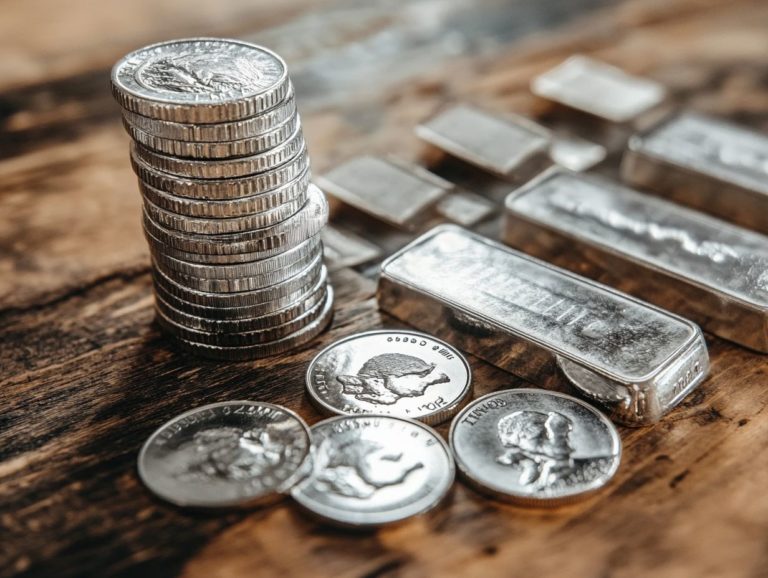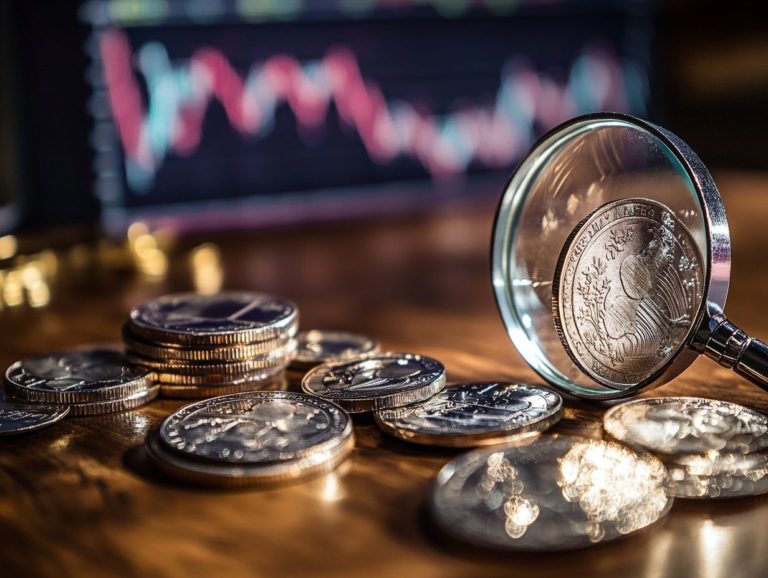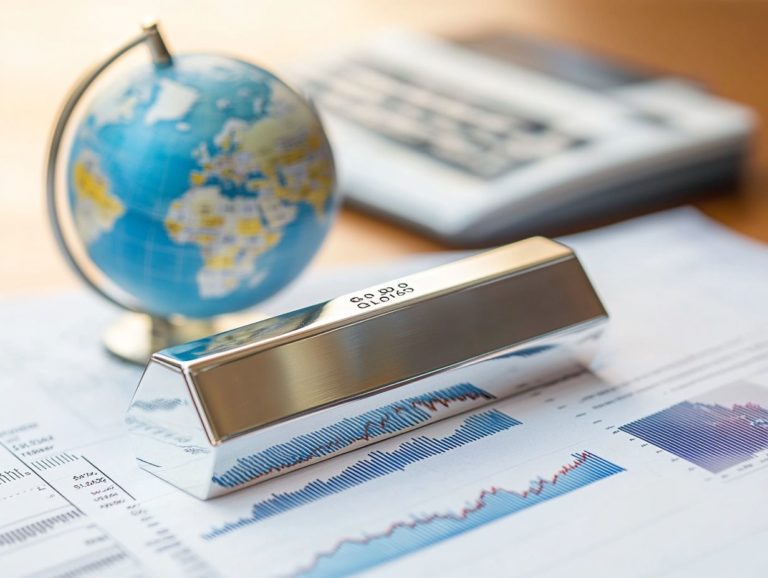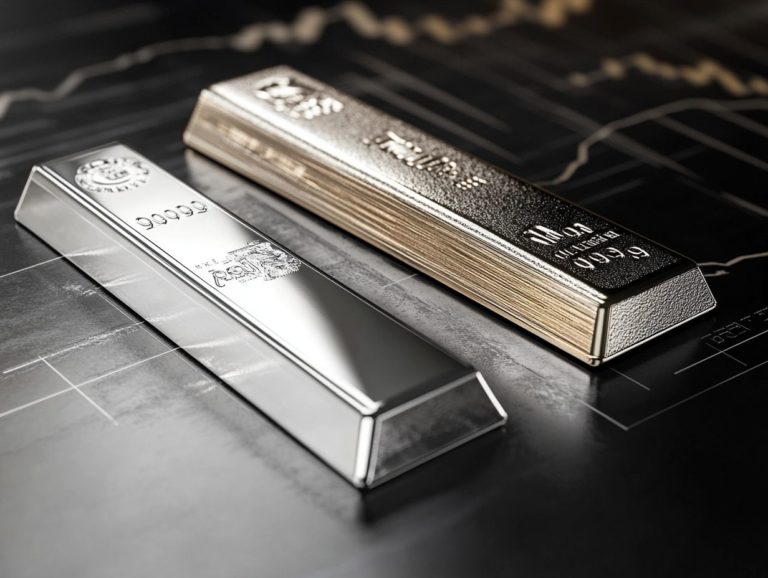The Impact of Geopolitical Factors on Palladium
Palladium, a precious metal that often finds itself in the shadows of gold and silver, plays an important role across various industries, particularly in automotive catalytic converters and electronics. You may be surprised to learn that its price is significantly swayed by geopolitical factors, such as the political stability in key producing countries, trade policies, and the intricate dynamics of global supply and demand.
This exploration delves into how these elements interconnect, influencing palladium prices and offering unique investment opportunities. Whether you re an investor or merely intrigued by the metal’s importance, grasping these factors is crucial in today s volatile market.
Contents
- Key Takeaways:
- Geopolitical Factors Affecting Palladium Prices
- Impact of Geopolitical Events on Palladium Prices
- Strategies for Investors in Palladium
- Frequently Asked Questions
- What are some examples of geopolitical factors that can impact the price of palladium?
- How do trade tensions between countries affect the price of palladium?
- Can economic policies impact the price of palladium?
- How do supply and demand dynamics play a role in the price of palladium?
- What are some potential geopolitical risks that could impact palladium?
- Is the impact of geopolitical factors on palladium always negative?
Key Takeaways:
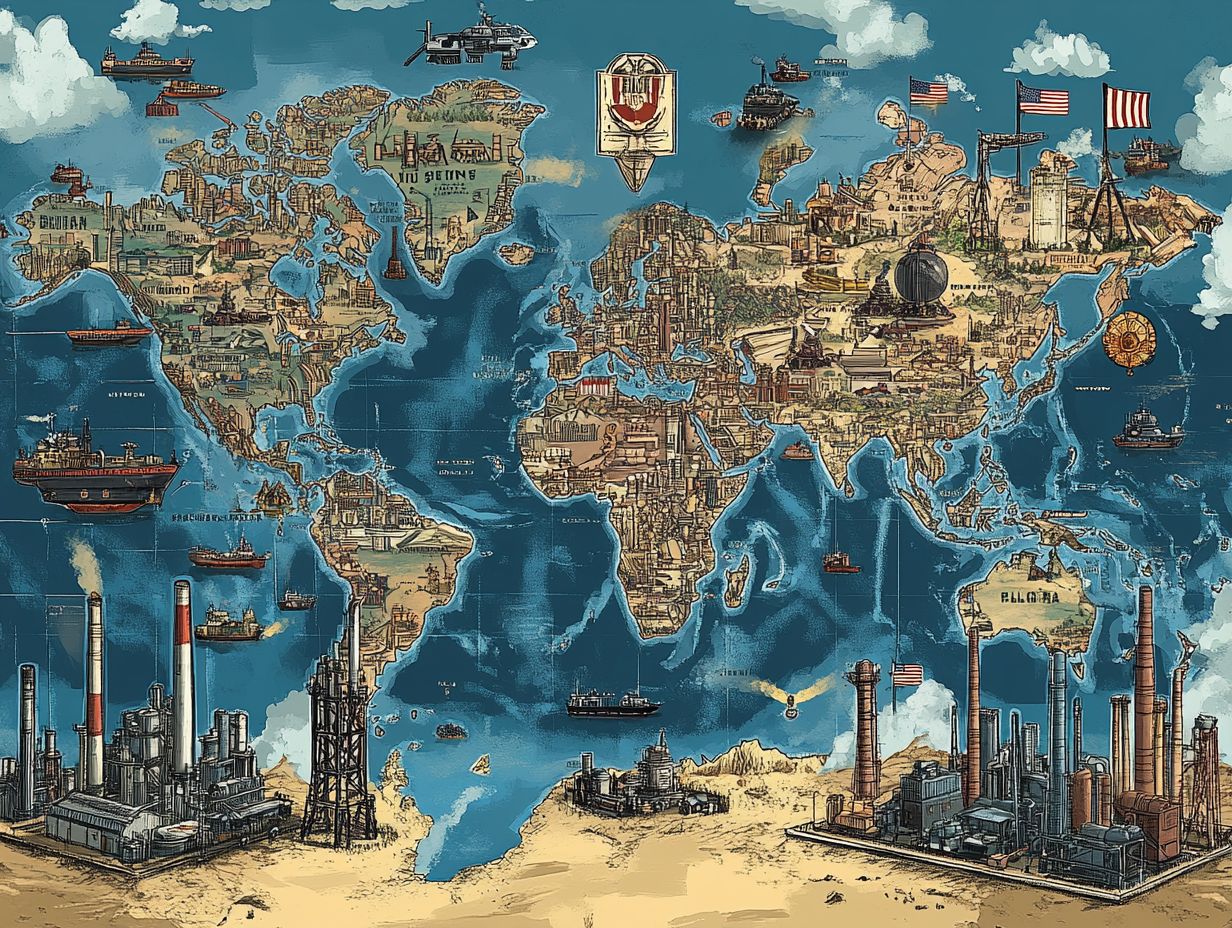
- Political stability in major producing countries can greatly impact the price of palladium, as any unrest or instability can disrupt production and supply.
- Trade policies and tariffs also play a significant role in palladium prices, as changes in these can affect global demand and supply dynamics.
- Investors in palladium should consider factors such as geopolitical events, government regulations, and market volatility when making investment decisions.
What is Palladium?
Palladium is a rare and precious metal that has captured significant attention in recent years, especially for its important role in the automotive industry and electronic components. As a member of the platinum group metals (PGMs), it s not just its industrial applications that make it valuable; the investment demand has also surged, influenced by various geopolitical factors and economic conditions in global markets.
This versatile metal is essential in catalytic converters, which are devices in cars that help reduce harmful exhaust emissions. In the world of electronics, palladium shines in connections and soldering for circuit boards, thanks to its exceptional conductive properties.
Its lustrous appeal has made it a favorite in fine jewelry, often chosen for its allergy-friendly properties. The constantly changing demand paired with its limited supply creates a dynamic market, prompting investors to view it as a strategic asset amid broader trends in precious metals and the evolving automotive landscape.
Role and Significance in Various Industries
Palladium holds a vital position across various industries, especially in the automotive sector, where it plays an essential role in reducing harmful emissions through intricate chemical reactions. Its industrial applications extend far beyond automotive use, impacting numerous technological advancements and shaping investment demand in the precious metals market.
In the electronics realm, you ll find palladium prized for its exceptional conductivity, making it a go-to choice for connectors and circuitry that enhance both performance and reliability in devices. Its biocompatibility further elevates its status, especially in dental applications, where it s often used in crowns and bridges, offering durability alongside a pleasing aesthetic.
With a growing emphasis on sustainability and green technologies, the demand for palladium is on the rise, influencing market trends and creating new investment opportunities. As industries work to meet regulatory standards and align with consumer expectations, this versatile metal remains a crucial component in advancing manufacturing processes and supporting environmental objectives.
Geopolitical Factors Affecting Palladium Prices
Geopolitical factors wield considerable influence over palladium prices, frequently causing fluctuations that mirror broader trends in national economies and market dynamics. Events like geopolitical unrest in key producing nations, such as Russia and South Africa, can create supply constraints, which in turn affect investment strategies and overall market confidence in precious metals.
Understanding these dynamics is essential for navigating the complex landscape of precious metal investments. Stay informed about your investments in palladium and related markets to ensure you’re making the best choices.
Political Stability and Unrest in Major Producing Countries
Political stability and unrest in major producing countries like Russia and South Africa are crucial elements that influence fluctuations in palladium prices. These conditions mirror the underlying geopolitical dynamics shaping global markets.
The ongoing tensions, especially those involving Russia, have led to significant disruptions in the palladium supply chain. These tensions don’t just cause production hiccups; they also stir investor concerns and create a cloud of uncertainty over the marketplace.
In South Africa, labor strikes and political protests have further complicated extraction processes. This impacts availability and contributes to heightened price volatility.
With demand for palladium skyrocketing, driven by its essential role in devices that reduce harmful emissions in cars, the balance between supply and demand becomes increasingly delicate. Market participants are keenly attuned to these geopolitical events, as they can trigger price surges or falls based on the perceived risks associated with sourcing this vital metal. Additionally, understanding the effect of inflation on palladium prices is crucial in navigating this complex market.
Trade Policies and Tariffs
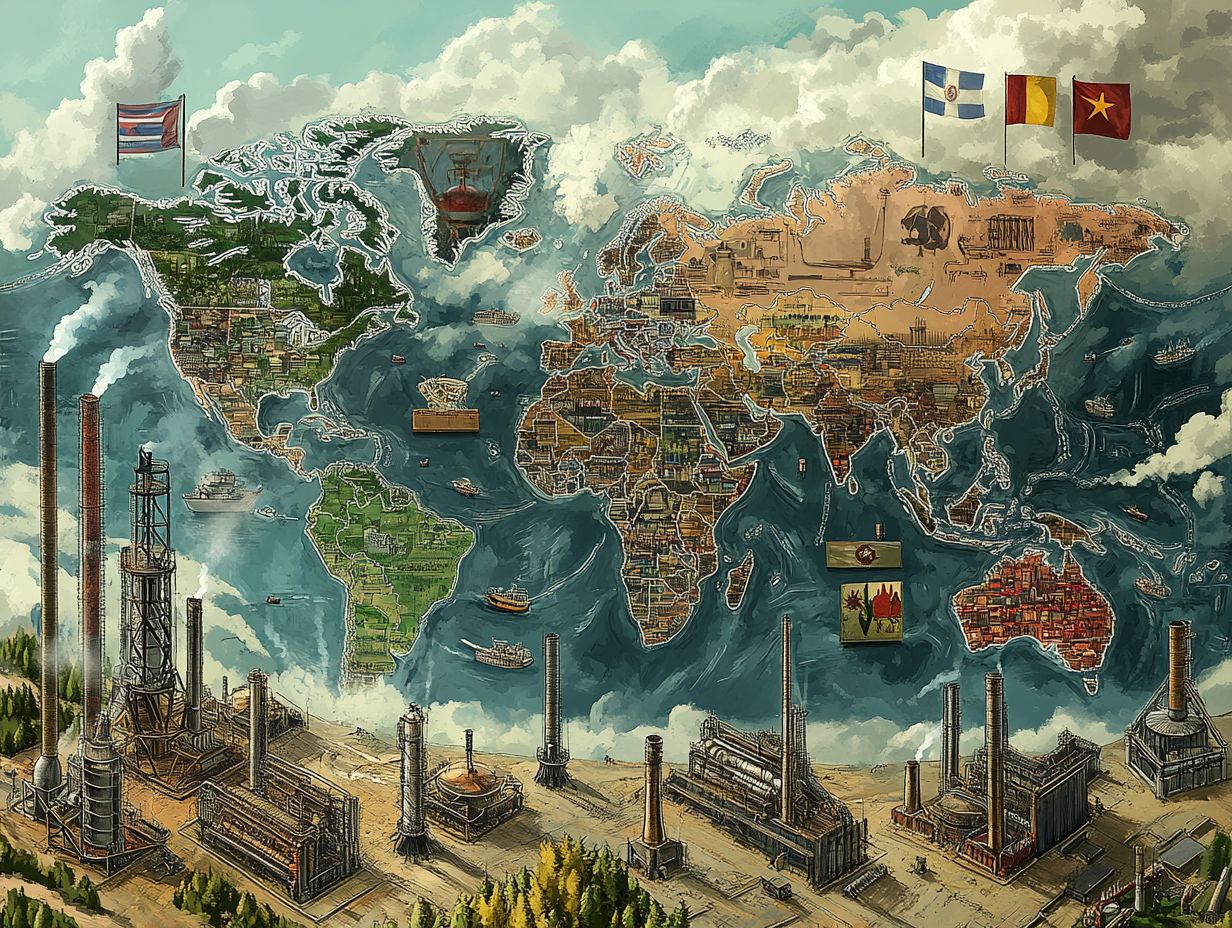
Trade policies and tariffs are important in shaping the palladium market, influencing supply chains and investment demand for this precious metal. When international trade agreements change, uncertainty can creep into market dynamics, affecting palladium prices and the overall economy.
For example, when tariffs are imposed on palladium imports, producers may encounter elevated costs. This could lead to reduced production levels, limiting the availability of palladium for various industries, such as automotive manufacturing and electronics.
As supply tightens, you might see prices surge, making palladium an attractive hedge against inflation and economic instability. Shifts in trade relationships can alter global demand, as consumers in various markets adjust their purchasing behaviors based on anticipated changes in pricing and availability.
This interconnectedness shows the delicate balance within the broader landscape of global markets.
Global Demand and Supply Dynamics
Global demand and supply dynamics play a crucial role in determining the price of palladium. They are influenced by various factors such as industrial usage, investment demand, and market speculation.
As you observe the automotive industry pivoting toward electric vehicle adoption, you ll notice the evolving dynamics of supply and demand for palladium, which directly impacts price fluctuations in global markets.
This transition is noteworthy, given that palladium has long been essential for catalytic converters in internal combustion engines, which are now losing their prominence. Geopolitical unrest in key mining regions and how national economies respond to these challenges further complicate the situation, resulting in unpredictable price trends influenced by factors affecting palladium prices.
As automakers pour significant resources into electric vehicles and alternative technologies, the competition for palladium could heat up, potentially leading to shortages. Therefore, it’s essential for you, whether you’re a manufacturer or an investor, to consider how these shifts may dictate supply levels and influence pricing strategies in an ever-evolving global landscape. Understanding the impact of world events on platinum can provide valuable insights into these dynamics.
Impact of Geopolitical Events on Palladium Prices
Geopolitical events wield considerable influence over palladium prices, frequently resulting in unforeseen fluctuations that mirror the broader economic landscape marked by turmoil and shifting market dynamics.
Factors such as natural disasters, conflicts, and alterations in government policies can instigate volatility and uncertainty, prompting adjustments in investment demand and strategies.
Natural Disasters and Unforeseen Events
Natural disasters and unforeseen events can significantly impact palladium prices. They often disrupt supply chains and alter market dynamics. When calamities like earthquakes or severe weather strike key producing regions, unexpected scarcity can arise, prompting shifts in your investment strategies within the precious metals market.
Consider a severe earthquake in South Africa, one of the major palladium producers. Such an event could halt mining operations and lead to a sharp increase in prices due to supply shortages. Similarly, a catastrophic flood in Russia could produce comparable effects. These occurrences affect immediate availability and create a ripple effect, influencing investor sentiment and escalating volatility, which highlights the growing influence of palladium in global markets.
By monitoring these external factors, you can better position your portfolio. Using strategies like spreading your investments across different areas can help you navigate the complexities that impact palladium prices.
Changes in Government Regulations and Policies
Changes in government regulations and policies can profoundly affect the palladium market. They influence everything from production quotas to trade restrictions and economic sanctions. These regulatory shifts often create uncertainty that leads to price fluctuations and alters market trends.
When governments tighten environmental regulations to reduce carbon emissions, this directly impacts the automotive industry, a significant consumer of palladium used in catalytic converters. Additionally, as the impact of inflation on silver prices becomes more pronounced, demand for palladium could soar, leading to higher prices—don’t miss out!
On the flip side, economic sanctions against key producing countries can disrupt supply chains, complicating market dynamics even further. Stay alert! These policy changes can dramatically shift your investment strategy!
Strategies for Investors in Palladium
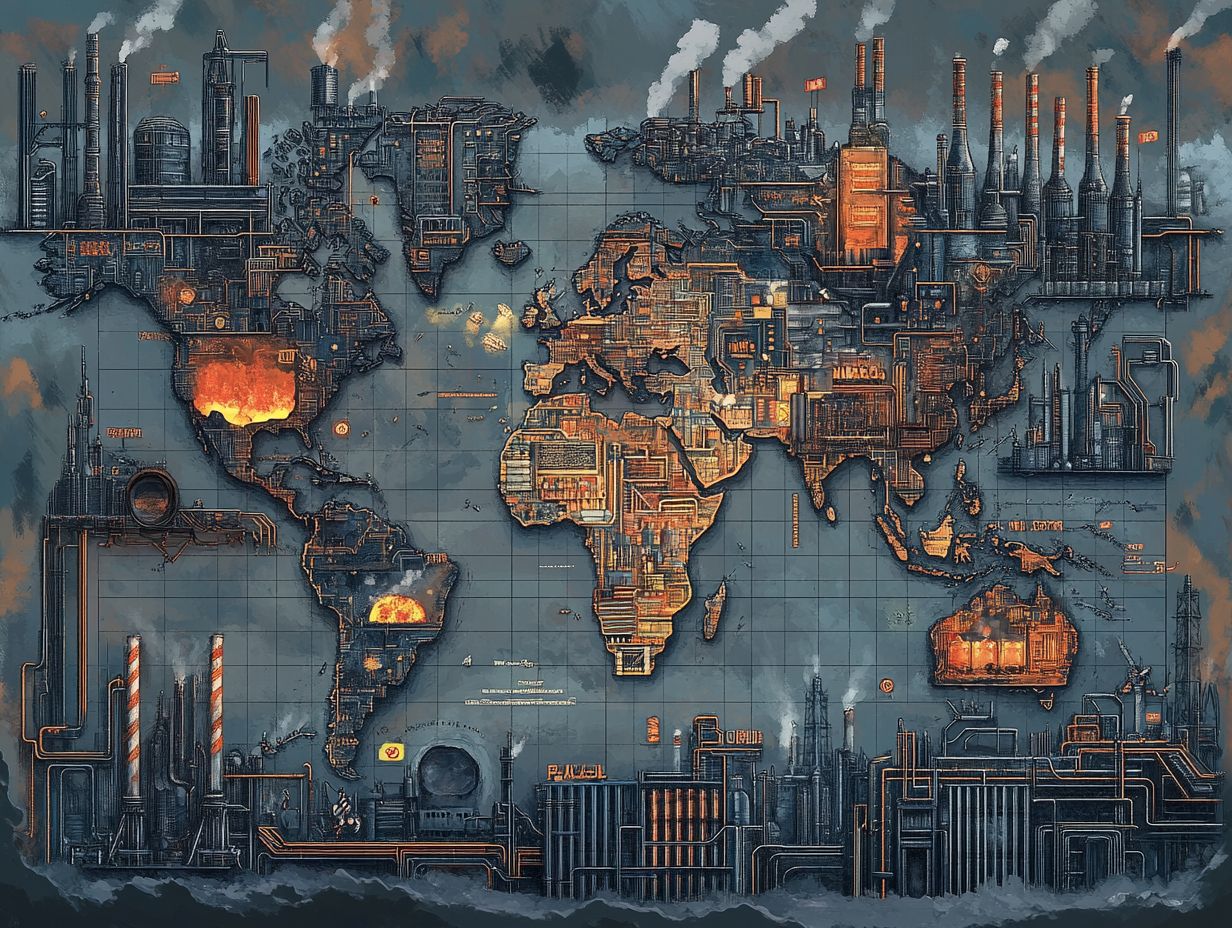
Investing in palladium requires a sophisticated grasp of market dynamics, price fluctuations, and strategic approaches to adeptly navigate the intricacies of this precious metal.
As geopolitical factors continue to influence the landscape, you must stay informed and flexible, ensuring you can manage risks confidently and precisely.
Factors to Consider When Investing in Palladium
When considering an investment in palladium, it s crucial to weigh several key factors. These include market dynamics, geopolitical risks, and the overall economic climate. Understanding the intricacies of supply and demand and external influences on prices is essential for making savvy investment choices.
Keep a close eye on geopolitical tensions, especially in major producing countries. These instabilities can dramatically affect production levels and, in turn, market prices. For instance, understanding the effect of geopolitical events on gold is crucial. Trends in related sectors also play a vital role, particularly in the automotive and electronics industries, where palladium is extensively used.
Economic indicators, including inflation rates and central bank policies, further guide your investment strategies by impacting the broader financial landscape. By weaving together these various elements in your analysis, you can position yourself more effectively to navigate the complexities of palladium investments. Additionally, understanding the effect of geopolitical events on silver prices can enhance your overall investment approach.
Managing Risks in a Volatile Market
Managing risks in the unpredictable palladium market is essential for you as an investor who aims to protect your portfolio while seizing potential opportunities. Act now to expertly navigate through the uncertainties that often stem from geopolitical tensions and market fluctuations.
Embrace diversification! It s a powerful strategy to safeguard your investments. By spreading your investments across various asset classes and sectors, you can reduce your exposure to any single market, giving you a more balanced approach.
Hedging can also serve as a valuable tool in your arsenal, allowing you to offset potential losses. This can be done through contracts that let you buy or sell an asset at a set price in the future, like options and futures contracts.
Staying informed about key geopolitical events such as trade policies and regulatory changes can significantly influence your investment decisions. These factors frequently introduce additional market volatility.
By blending these strategies with comprehensive market analysis, you can adapt your approach in response to shifting conditions. Ultimately, this secures your financial interests with confidence.
Frequently Asked Questions
What are some examples of geopolitical factors that can impact the price of palladium?
Some examples include:
- Trade tensions between countries
- Economic policies
- Supply and demand dynamics
How do trade tensions between countries affect the price of palladium?
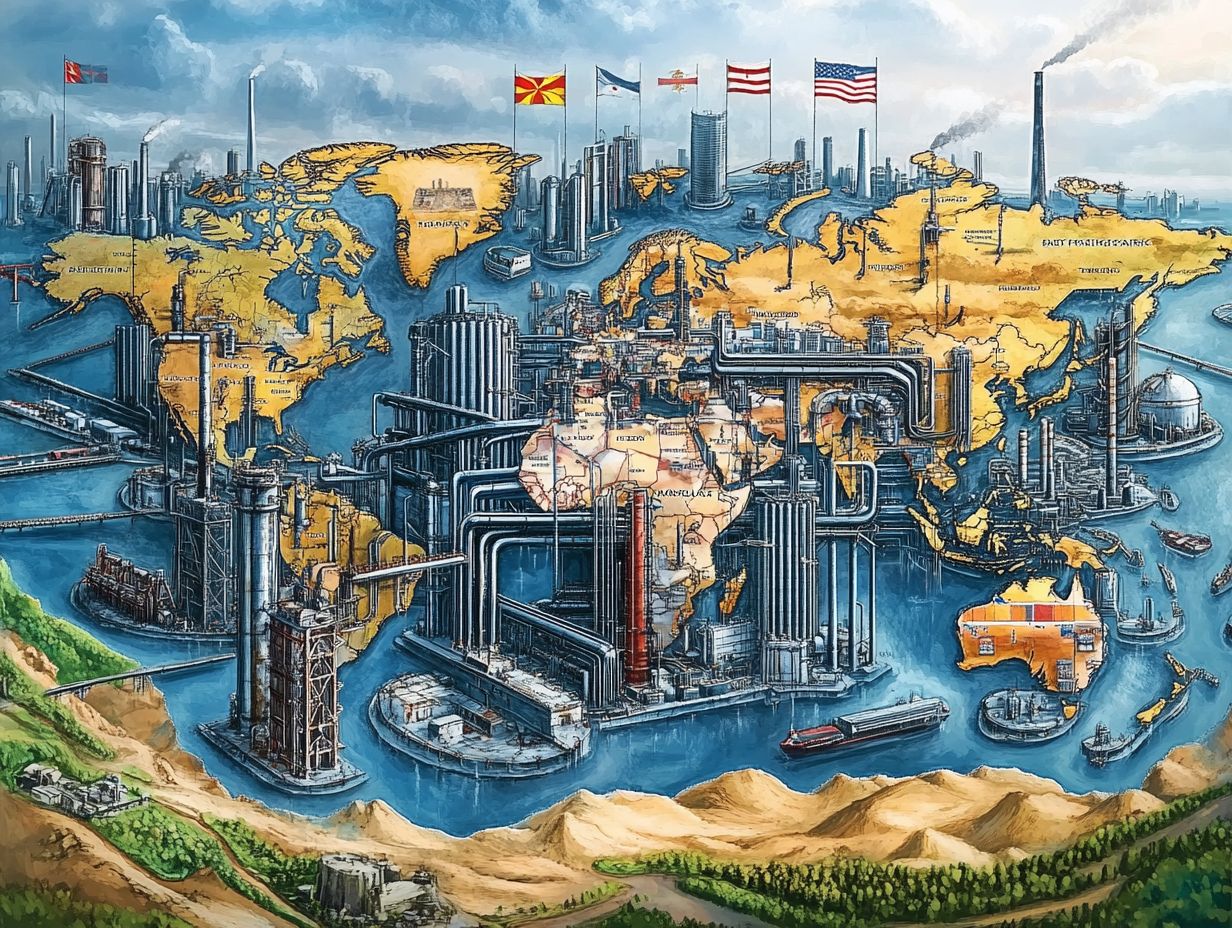
Trade tensions can lead to tariffs and restrictions on imports and exports, impacting the availability and cost of palladium directly.
Can economic policies impact the price of palladium?
Yes, economic policies such as interest rates, inflation rates, and government spending can affect the demand for palladium in various industries, thus impacting its price.
How do supply and demand dynamics play a role in the price of palladium?
Palladium is a finite resource. Its availability can be impacted by factors such as mining regulations, production levels, and recycling rates. Changes in demand from industries like automotive and electronics can also affect its price.
What are some potential geopolitical risks that could impact palladium?
Some potential risks include:
- Political instability in major mining countries
- Changes in trade agreements
- Global economic downturns
Is the impact of geopolitical factors on palladium always negative?
No, geopolitical factors can also have a positive impact. For example, government policies that promote the use of palladium in clean energy technologies can lead to an increase in demand and prices.
Stay informed and take proactive steps regarding your investments!










